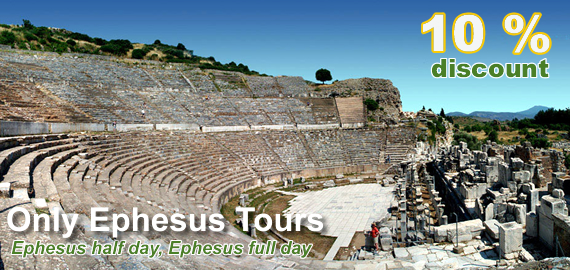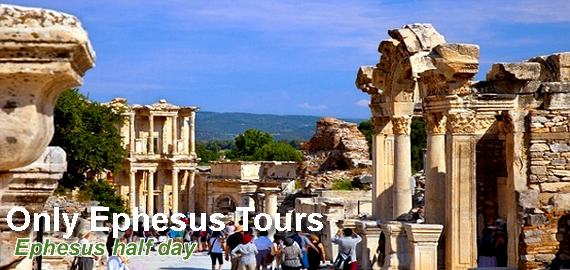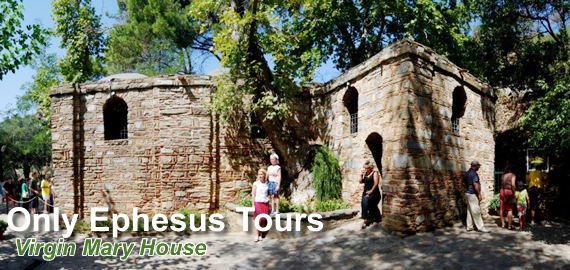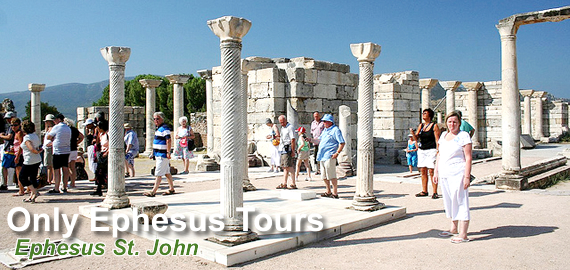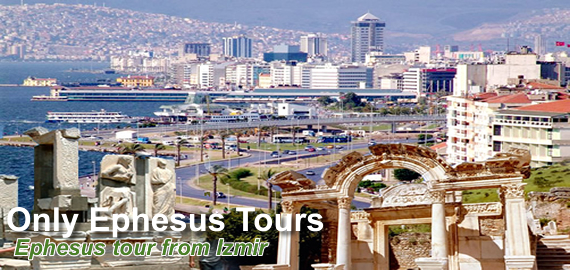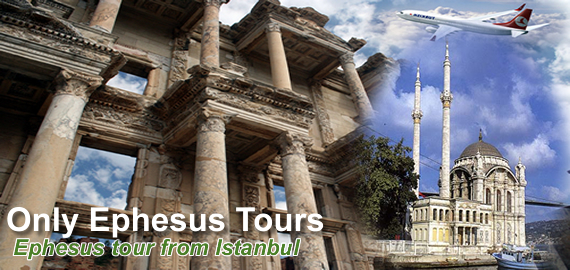Where is Ephesus, Ephesus Information, About Ephesus
 Where is Ephesus, About Ephesus Ephesus Information
Where is Ephesus, About Ephesus Ephesus Information
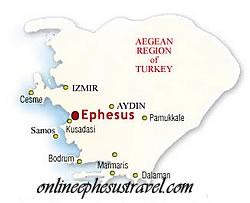 d back.
d back.Where is Ephesus, Ephesus Information, About Ephesus
Where is Ephesus
The
ancient city of Ephesus near the modern town of Selcuk, about 50 km
south of Izmir (Smyrna) in Turkey.
Location: Ephesus was constructed on a river bend, that was eventually
dredged into a full harbor near the mouth of the Cayster River, on the
western coast of Asia Minor (modern Turkey). Along the coastal plain
between Smyrna to the north and Miletus to the south, the site is now
about six miles from the Aegean Sea. The city shifted in five distinct
locations over time, each within a small area.
The Apostles Paul and John were familiar with the city that scholars
have dubbed "Ephesus III" the largest (in area) of the five. The areas
where Ephesus located are as follows: Ephesus I: Aya Suluk (St. John
Area); Ephesus II: Artemission area; Ephesus III: Port of St. Paul: base
of Mount Koressos; Ephesus IV: north of Aya Suluk; Ephesus V: Selçuk
area. Because of the man-made harbor structure and the flow of the
river, a backwash flow caused the harbor to frequently silt up (by 449
BCE we already read of problems documented about the silting.
Later, Eusebius records that Ephesus honored Emperor Hadrian for
dredging and making navigable the harbor). When cleared, Ephesus was in
a location that justified a great seaport. The city sat at the
convergence of three land routes with a shipping lane from the north via
the channel created by the Island of Chios and an opening facing the
cities of Macedonia.
The land routes that converged on Ephesus included: 1) The Colossae /
Laodicea road (travelling east), 2) The road to Sardis and Galatia
(northeast), and 3) The Smyrna (north) main road.
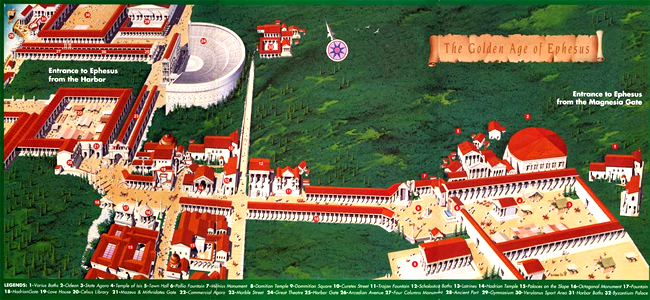
Please click on the images and
see in 3D animation..
Ephesus is discovered in Selcuk, Izmir in western Turkey. Kusadasi is 19
km. far away from Ephesus and Pamucak beach is 5 km far away from
Ephesus.
The original site of Ancient Ephesus was most likely established
on the Aegean coast, on the shores of that sea which is today located 8
km. away from the archaeological excavations.
Over the centuries, in fact, the rubble brought on to the plain of the "Kucuk
Menderes" has enlarged the alluvial plain surrounding the
archaeological zone, leaving behind in actual fact the shores of the
Aegean. In Roman times it was situated on the northern slopes of the
hills Coressus and Pion and south of the Cayster (Kucuk
Menderes) River, the silt from which has since formed a fertile
plain but has caused the coastline to move ever farther west. In Roman
times a sea channel was maintained with difficulty to a harbor well west
of Pion. By late Byzantine times this channel had become useless, and
the coast by the mid-20th century was three miles farther west.
Ephesus (Efes) is close to the town of Selcuk about an hour drive south
of Izmir. Kusadasi is the nearest larger town, about 20km from
Ephesus.
Ephesus is discovered in Selcuk, Izmir in western Turkey. Kusadasi is
19 km. far away from Ephesus and Pamucak beach is 5 km far
away from Ephesus.
The original site of Ancient Ephesus was most likely established
on the Aegean coast, on the shores of that sea which is today located 8
km. away from the archaeological excavations.
Over the centuries, in fact, the rubble brought on to the plain of the "Kucuk
Menderes" has enlarged the alluvial plain surrounding the
archaeological zone, leaving behind in actual fact the shores of the
Aegean. In Roman times it was situated on the northern slopes of the
hills Coressus and Pion and south of the Cayster (Kucuk Menderes) River,
the silt from which has since formed a fertile plain but has caused the
coastline to move ever farther west. In Roman times a sea channel was
maintained with difficulty to a harbor well west of Pion. By late
Byzantine times this channel had become useless, and the coast by the
mid-20th century was three miles farther west.
Ephesus (Efes) is close to the town of Selcuk about an
hour drive south of Izmir. Kusadasi is the nearest larger
town, about 20km from Ephesus.
View Larger Map
Ephesus Location:
Ephesus was constructed on a river bend, that was eventually dredged
into a full harbor near the mount of the Cayster River, on the western
coast of Asia Minor (modern Turkey). Along the coastal plain between
Smyrna to the north and Miletus to the south, the site is now about six
miles from the Aegean Sea. The city shifted in five distinct locations
over time, each within a small area. The Apostles Paul and John were
familiar with the city that scholars have dubbed "Ephesus III" the
largest (in area) of the five.
The areas where Ephesus located on as follows:
Ephesus I: Aya Suluk (St. John Area);
Ephesus II: Artemission area;
Ephesus III: Port of St. Paul: base of Mount Koressos;
Ephesus IV: north of Aya Suluk;
Ephesus V: Selcuk area.
Because of the man-made harbor structure and the flow of the river, a
backwash flow caused the harbor to frequently silt up (by 449 BCE we
already read of problems documented about the silting. Later, Eusebius
records that Ephesus honored Emperor Hadrian for dredging and making
navigable the harbor). When cleared, Ephesus was in a location that
justified a great seaport. The city sat at the convergence of three land
routes with a shipping lane from the north via the channel created by
the Island of Chios and an opening facing the cities of Macedonia.
The land routes that converged on Ephesus included:
1) The Colossae / Laodicea road (traveling east),
2) The road to Sardis and Galatia (northeast), and
3) The Smyrna (north) main road.
Population:
Some scholars estimate the number of people living at Ephesus to have
exceeded 250,000 inhabitants during Ephesus III, which would make it
perhaps the fourth largest of its day behind:
1) Rome;
2) Alexandria; and
3)An Antioch. This large a city was an economic stronghold in Asia
Minor, and justified the title supreme metropolis of Asia though there
is an evidence that its overall economic standing may have been slowly
declining.


